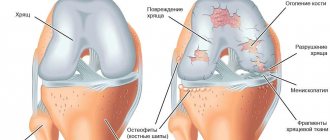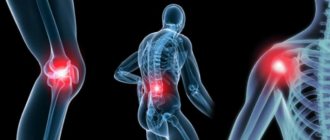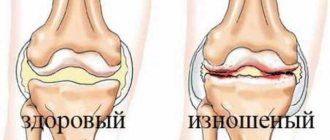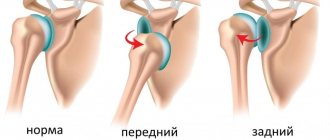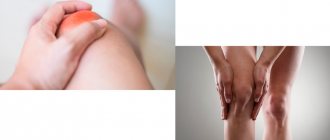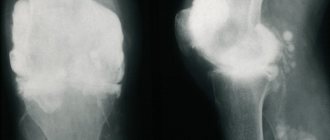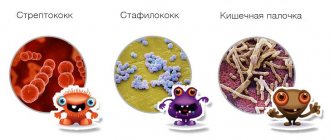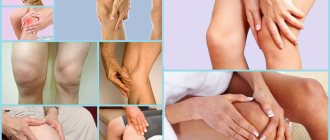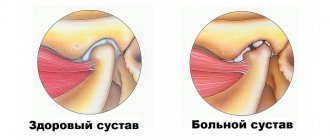How to treat synovitis of the knee joint: general principles
After examination and diagnosis, the optimal method of therapy is selected, which depends on the type and stage of inflammation, as well as the individual health characteristics of the patient.
An integrated approach includes:
- performing a puncture;
- fixing the immobility of the affected knee joint;
- taking medications;
- physical therapy;
- traditional medicine methods.
Surgical intervention is indicated in the absence of results of conservative treatment.
Each form of synovitis of the knee joint has its own characteristics and subtleties of treatment, requiring a special approach and detailed analysis of all the nuances.
Diagnostic measures
In order to obtain the most accurate diagnosis, when the first signs of an inflammatory process appear, it is recommended to immediately seek professional medical help.
The key diagnostic method is puncture (extraction of a small amount of joint fluid for the purpose of research). The most informative is bacteriological or bacterioscopic analysis of the extracted material.
The type of pathogenic microflora present is determined. It is mandatory to analyze the resistance of identified bacteria to antibacterial agents.
In addition, at the diagnostic stage, instrumental methods are also important, which include:
- arthroscopy;
- arthropneumography;
- CT/MRI.
If there are symptoms suggesting benign or malignant neoplasms, patients are prescribed a biopsy of the affected membrane.
Based on the results obtained, the severity of a particular clinical case is determined, which helps to outline ways to resolve it.
Taking medications
Only medications prescribed by the attending physician are indicated for use:
- NSAIDs. Relieves pain, reduces the severity of the inflammatory process;
- Antiviral drugs. In the event that the tests performed reveal the viral nature of the disease;
- Antibiotics. Cures lesions caused by bacterial infection;
- Antihistamines. Relieves allergic manifestations.
- Immunostimulants, vitamin-mineral complexes, dietary supplements. Restores the immune system and strengthens the body.
Causes of synovitis and tenosynovitis
Synovitis is one of the symptoms of rheumatoid arthritis of an autoimmune (unexplained) nature. Chronic inflammation of synovial membranes provokes inflammatory processes in other organs - a full-scale process is launched in the body, causing a person no less pain than arthrosis of the knee joint in advanced forms.
Synovitis can also occur with the following diseases:
- juvenile arthritis;
- psoriatic arthritis;
- lupus;
- rheumatic fever;
- gout;
- tuberculosis;
- injuries.
The causes of tenosynovitis still raise questions. It is believed that inflammation occurs after excessive strain on the tendons, but this is just a guess. Obviously, due to increased physical activity, tendons, surrounding muscles and bones are injured, so the risk of inflammation of the membranes increases.
Folk remedies that help with synovitis
To treat diagnosed synovitis of the knee joint of a non-dangerous form, you can use some traditional medicine:
- lotions based on herbal decoctions;
- rubbing with medicinal tinctures;
- taking herbal teas or herbal decoctions;
- ointments made from animal fats.
Any means are used only as an addition to the main treatment prescribed by a medical specialist. A combination of drug therapy, physical therapy and home treatment can provide an accelerated positive effect.
The standard treatment regimen includes:
- non-steroidal anti-inflammatory drugs to relieve swelling and reduce pain;
- short-term corticosteroids;
- cold compresses to reduce pain and swelling;
- rest to reduce the load on the joint;
- antibiotic therapy - in the presence of a bacterial infection.
If the joint is severely damaged, sometimes synovitis can only be cured by surgery
Is it worth pumping out fluid from the knee joint? Opinion of a practicing orthopedic traumatologist:
Synovitis is often diagnosed in people with degenerative joint diseases. Damaged cartilage surfaces become inflamed and fluid accumulates in the joint. In such conditions, it is impossible to begin treatment for osteoarthritis. It is necessary to stop the inflammation, and only after that undergo a course of intra-articular injections of synovial fluid prosthesis or resort to other, less effective therapy.
Surgery
The minimum intervention in the body is arthroscopy, a procedure to clarify the condition of the organ, clarify the diagnosis, and also perform a biopsy of damaged tissue. The therapeutic effect of arthroscopy is to reduce swelling due to drug treatment of the internal cavity of the joint.
Complete or partial removal of the affected tissue is carried out during synovectomy. The operation is indicated for patients with dangerous forms of the disease, an acute unpredictable course of the disease, as well as chronic, often recurrent synovitis. The operated joint is immobilized for a week, but movement is possible already on the second day after the intervention. Rehabilitation is long.
Types of disease
Synovitis is divided into two large groups - non-infectious and infectious. Among the non-infectious ones we can highlight:
- traumatic: caused by excessive physical exertion and injuries during sports;
- allergic: caused by taking medications, exotic fruits or any other contact with an allergen (plant pollen, animal dander);
- neurogenic: occurs due to severe stress or neurological diseases;
- endocrine – provoked by endocrinological pathologies (diabetes mellitus).
Infectious synovitis can be caused by pathogenic microorganisms that provoke inflammation in the synovial membrane with spread to soft tissue. It can also result from a complication of a purulent-inflammatory process already present in the body.
Depending on the nature of the course, there is an acute form, which develops rapidly, and a chronic form, with gradually increasing symptoms.
In acute synovitis, a change in the shape of the joint can be observed; it increases in volume in just a few hours or days, swelling and thickening of the synovial membrane appear. Acute synovitis is characterized by:
- moderate increase in body temperature;
- pain on palpation;
- the appearance of clear or translucent fluid in the joint cavity.
A person feels aching and bursting pain, weakness and malaise. Movement in the joint is limited.
With chronic synovitis, clinical symptoms are mild. The patient may complain of fatigue, fatigue while walking, aching pain that is constant, and minor discomfort when moving. In this case, all metabolic processes and blood circulation are disrupted.
Rehabilitation and exercise therapy
To speed up the restoration of limb mobility to the previous extent after conservative or surgical treatment of synovitis, physical therapy exercises are recommended. The time frame for starting them is determined by the attending physician.
For classes, a special set of exercises that do not cause pain is selected. The goal is to eliminate high stress on muscles and joints. Exercises are carried out from static positions lying or sitting, affecting relaxation or stretching of muscles. Regular exercise increases physical endurance and makes tendons elastic.
The positive effect of gymnastics is to reduce pain, stabilize the production of synovial fluid, expand the range of organ mobility, and create a positive attitude toward recovery.
Positive progress in well-being can be consolidated by walking, as well as exercising on an exercise bike or elliptical machine.
Main symptoms
With synovitis, most often only one joint is affected, but sometimes the disease is multiple.
The main symptoms of synovitis can be considered:
- increase in volume and smoothing of the contours of the joint;
- pain during exercise;
- pronounced swelling of soft tissues;
- difficulty moving;
- skin hyperemia;
- chills and general malaise.
If we talk about infectious synovitis, it almost always begins acutely: the patient feels severe throbbing pain, and the body temperature rises sharply. After some time, the knee joint swells, signs of general intoxication of the body appear: weakness, drowsiness, headache, nausea and even vomiting.
The non-infectious form develops quite slowly. First, the synovial membrane, which lines the joint capsule from the inside, becomes inflamed and also produces synovial fluid (synovium). The first sign is a feeling of discomfort in the area of the affected knee joint, as well as pain during exercise. Swelling gradually appears, and painful sensations increase.
If you find yourself with such symptoms, then do not self-medicate, but immediately make an appointment with a doctor.
Prognosis for the course of the disease
For a favorable prognosis, factors such as the condition of the patient’s body, as well as timely effective treatment, are important. Complete recovery with preservation of the same motor activity is possible with the mildest forms of the lesion, as well as with the serous or allergic variant of the disease.
The severe course of the purulent form poses a threat to life, since a septic lesion develops. With the most favorable developments in this case, there is a high probability of stiffness or complete immobility of the affected organ, as well as dangerous complications on other organs and systems of the body.
Why is synovitis dangerous?
The synovial membrane performs an important function in the joint - it ensures the separation of hard tissues. Due to this, the joint moves with minimal bending of the components. The membrane is capable of changing shape, thereby adapting to supporting surfaces and providing shock absorption. The quality and quantity of synovial fluid in the joint depends on its condition, the same fluid whose deficiency develops coxarthrosis or gonarthrosis.
The connective tissue that forms this membrane can become inflamed. Swelling forms in the joint, during movement the person feels pain, and bleeding is possible. If the disease is not treated, the synovial membrane thickens and new blood vessels appear in it. In the future, this will lead to frequent joint bleeding.
Synovitis without treatment can lead to joint dysfunction
Clinic of Dr. Dlin in Moscow: treatment of synovitis of the knee joint
Prevention and treatment of the disease are one of the key areas of activity of a medical institution. Patients have access to a full course of therapy from specialized diagnostics, identification of causes, elimination of pain, to elimination of the causes of pain. Our specialists have undergone specialized training and specialization in the world's leading clinics and have extensive positive experience in this area.
Clinic offer:
- international level of therapy using the latest innovative developments;
- modern diagnostic, laboratory and treatment equipment;
- collaboration of a group of experienced specialists in the field of synovitis;
- rapid relief of pain;
- comfortable cozy atmosphere and attentive staff.
Call and register for a free initial medical appointment!
What is tenosynovitis
Tenosynovitis is an inflammation of the tendon sheaths. The latter are tubular-shaped connective tissue filled with liquid lubricant. The sheaths surround the tendons, which are made of flexible fibrous collagen tissue. It is what attaches muscles to bones. If the outer covering of the tendons becomes inflamed, it is called tenosynovitis. Both inflammatory diseases are accompanied by pain when moving, so only a doctor can make an accurate diagnosis.
Tenosynovitis most often affects the hands, wrists and feet
Treatment of acute traumatic synovitis
The treatment regimen for this form of synovitis can be divided into the following points:
1) Treatment of injury - if it is an open fracture, the surgeon restores the normal position of the bones inside the joint, sutures the damaged ligaments and areas of the capsule (if there are damages) and sutures the skin over the wound.
2) For open and closed intra-articular fractures, the patient is subjected to “skeletal traction” - wires are pulled through the bones that form the joint and a weight is suspended to avoid their re-displacement. Typically, the patient should remain in this condition for up to 3 weeks, unless surgery has been previously scheduled.
3) If symptoms of synovitis occur at any time, the patient is prescribed:
- Non-hormonal anti-inflammatory drugs (NSAIDs) intramuscularly or in tablet form. Most often used: Diclofenac, Ketorolac (Ketoprofen, Ketorol), Ibuprofen, Nimesulide (Nise).
- To eliminate side effects in the form of stomach and duodenal ulcers, “proton pump inhibitors” are prescribed - Rabeprazole, Omerpazole, etc.
- If there is significant swelling in the knee area or examination methods reveal a large amount of fluid inside the joint, the patient is punctured and the excess volume is removed.
- During the period of “skeletal traction,” the patient is sent to undergo physiotherapeutic procedures (photo- or magnetic therapy), which promote tissue healing. They also produce an anti-inflammatory effect, which reduces the severity of synovitis.
4) After removing the pins, the damaged leg is cast for at least 6-8 weeks. During this period, synovitis is quite rare. And even if it occurs, it can only be detected by removing the plaster cast. Treat according to the above scheme.
Orthopedics and traumatology services at CELT
The administration of CELT JSC regularly updates the price list posted on the clinic’s website. However, in order to avoid possible misunderstandings, we ask you to clarify the cost of services by phone: +7
| Service name | Price in rubles |
| Appointment with a surgical doctor (primary, for complex programs) | 3 000 |
| MRI of the elbow joint (1 joint) | 7 000 |
| Ultrasound of soft tissues, lymph nodes (one anatomical zone) | 2 300 |
All services
Make an appointment through the application or by calling +7 +7 We work every day:
- Monday—Friday: 8.00—20.00
- Saturday: 8.00–18.00
- Sunday is a day off
The nearest metro and MCC stations to the clinic:
- Highway of Enthusiasts or Perovo
- Partisan
- Enthusiast Highway
Driving directions
Therapy for villous nodular synovitis
This form of synovitis is, by its nature, a benign tumor. The most effective treatment option is removal of the formation. For this purpose, arthroscopic operations are currently performed:
- make two small incisions of 1-2 cm each;
- they are used to remove the tumor;
- After the procedure, the incisions are sutured;
- instruments are inserted into the joint. One of them is a camera with a flashlight, and the second is an electric knife or tweezers.
Complications after such manipulations occur very rarely. They do not require long hospitalization - on average, the patient stays in the hospital for 4-7 days.
Treatment of acute infectious synovitis
In this form, inside the joint, in addition to excess fluid, there is pus and bacteria, which gradually destroy cartilage, ligaments and capsule. Therefore, it is important to perform a puncture of the knee joint in a timely manner with the introduction of disinfecting solutions.
After puncture, antibacterial drugs and NSAIDs are prescribed. Anti-inflammatory therapy is carried out similarly to that for acute traumatic synovitis. Antibiotics are prescribed penicillin or macrolides. They have the best effect with minimal side effects. The following drugs are indicated:
Macrolides:
- Erythromycin;
- Azithromycin;
- Josamycin (recommended for children or pregnant women).
Penicillins:
- Amoxicillin;
- Ampicillin;
- Amoxiclav (if the above medications are ineffective or the patient has recently taken antibiotics).
Physiotherapeutic procedures are contraindicated in infectious processes, because they contribute to an increase in the number of bacteria. Therefore, this treatment method is not used for infectious synovitis.
